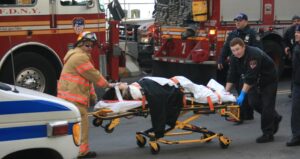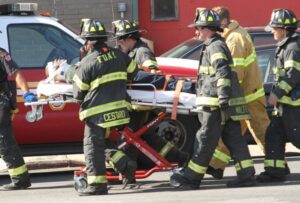Back to: Physical and Health Education JSS 2
Welcome to class!
In today’s class, we shall be talking about securing the environment, vehicles, and victims during rescue operations. Please enjoy the class!
Rescue Operations – Securing the Environment, Vehicles, and Victims
Emergencies can strike anywhere, anytime. Whether it’s a natural disaster, a car accident, or a building fire, being prepared and knowing how to react can make a life-or-death difference. This class delves into the crucial aspects of a rescue operation: securing the environment, vehicles, and victims.
Securing the Environment:

The first step in any rescue operation is assessing the environment. Is it a collapsed building, a raging wildfire, or a flooded street? Different scenarios demand different approaches. Here are some key points to consider:
- Identify hazards: Look for immediate threats like fire, falling debris, electrical wires, or unstable structures.
- Establish a perimeter: Prevent curious onlookers from entering the danger zone and hampering rescue efforts.
- Secure utilities: If possible, shut off gas, electricity, and water supplies to minimize further risks.
- Communicate effectively: Inform emergency personnel about the situation and potential dangers.
Securing the Vehicles:
Involving vehicles, prioritize these actions:

- Turn off engines and ignition: This prevents fires and potential fuel spills.
- Apply parking brakes: Ensure vehicles don’t roll and cause further damage.
- Stabilize unstable vehicles: Use blocks or wedges to prevent them from tipping over.
- Disconnect batteries: This reduces the risk of electrical shocks during rescue operations.
Securing the Victims:

Victim safety is paramount during rescue operations. Remember these crucial steps:
- Assess injuries: Quickly check for consciousness, breathing, and responsiveness.
- Control bleeding: Apply direct pressure to wounds to stop blood loss.
- Immobilize fractures: Use splints or slings to prevent further bone movement and pain.
- Maintain body temperature: Cover victims with blankets to prevent hypothermia or heatstroke.
- Provide emotional support: Stay calm, reassure victims, and offer words of encouragement.
Remember:
- Safety first: Never put yourself in danger while trying to help others.
- Call for help immediately: Contact emergency services as soon as possible.
- Follow instructions: Listen to and cooperate with trained professionals on the scene.
- Basic first aid knowledge: Knowing CPR and basic first aid can make a crucial difference.
Other important Tips:
- Stay updated: Regularly attend first aid and CPR training courses to keep your skills sharp.
- Assemble an emergency kit: Keep a backpack stocked with essential supplies like bandages, water, and a flashlight.
- Raise awareness: Educate your family and friends about basic rescue procedures.
By understanding these critical steps for securing the environment, vehicles, and victims, you can be prepared to act effectively in an emergency situation. Remember, even small actions can save lives.
We have come to the end of today’s class. I hope you enjoyed the class!
In the next class, we shall be discussing Tools Used in Rescue Operations.
In case you require further assistance or have any questions, feel free to ask in the comment section below, and trust us to respond as soon as possible. Cheers!
Question Time:
- Scenario: You arrive at a collapsed building site. What are the first three things you would do to assess the environment for safety?
- Imagine a raging wildfire blocks your escape route. How would you identify a safe path through the flames?
- A car is precariously dangling from a cliff edge. Describe two different methods you could use to stabilize it before attempting a rescue.
- Image of car dangling from a cliff edge.
